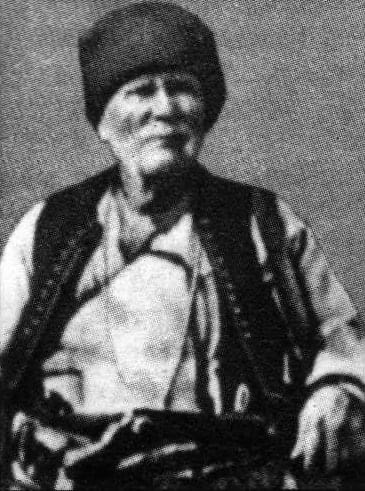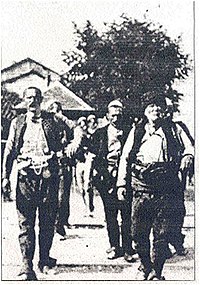Idriz Seferi
Idriz Seferi | |
|---|---|
 | |
| Nickname(s) | İdriz Bey |
| Born | 14 March 1847 Sefer, Kosovo Vilayet, Ottoman Empire |
| Died | 25 March 1927 (aged 80) |
| Allegiance | League of Prizren League of Peja |
| Service/ | Kachak |
| Years of service | 1878–1918 |
| Rank | Commander |
| Commands held | Gjilannahia Ferizovik area (1912) |
| Battles/wars | Albanian Revolt of 1910 Albanian Revolt of 1912 Balkan Wars |
| Awards | Hero of Kosovo (posthumously) |
Idriz Seferi 14 March 1847 – 25 March 1927 was an Albanian leader and guerrilla fighter (rebel). A member of the League of Prizren and League of Peja, he was the right-hand man of Isa Boletini, with whom he organized the 1910 Uprising against the Ottoman Empire in the Kosovo Vilayet. After the suppression of the uprising, Seferi continued warfare, in the 1912 Uprising. In the First Balkan War, Boletini and Seferi rose up against Serbia, with whom they had previously been allies to during the 1910 and 1912 Uprisings, and continued to attack Serbian posts in the subsequent occupation and initial phase of World War I (1913-1915). In the second phase of the war (1916-1918), he led troops against Bulgarian forces.
Life[]
Early life[]
Idriz Seferi was born in a Muslim family in the village of Sefer (in modern-day Preševo, south Serbia), to the north of the mountain range known as Black Mountain of Skopje (Turkish: Karadağ, Albanian: Mali i Zi i Shkupit, Serbian Latin: Skopska Crna Gora),[1] at the time part of the Ottoman Kosovo Vilayet. He joined the Albanian national movements at an early age,[2] being a member of the League of Prizren (est. 1878) and the League of Peja (est. 1899).[1]
Prelude to revolt[]
Before the general Albanian uprisings in the Ottoman Empire, Seferi had wanted to establish relations with the Serbian government; this was also done by Albanian chiefs in Yakova (Gjakova/Đakovica), İpek (Pejë/Peć) and in Montenegro.[3][unreliable source?] In 1909, the Serbian government aided the Albanian rebels with money and weapons.[verification needed]
1910 Uprising[]

In early April 1910, twelve Albanian tribes of the Kosovo Vilayet led by Isa Boletini and Idriz Seferi rose up against the Ottomans.[4] 5,000 rebels under Seferi cut off the Pristina-Üsküp railway at Kaçanik,[4] managing to resist the Ottoman forces at the gorge of the Kaçanik Pass.[1][5] Seferi's men stopped a train carrying soldiers and supplies bound for Pristina, carried off the supplies and disarmed the soldiers.[1][6] Boletini at the same time had led 2,000 rebels onto Ferizovik (Ferizaj) and Prizren.[4] Seferi inflicted heavy losses on the Turkish army despite the fact that they were without artillery[7] and held the pass for more than a fortnight. The rebels were only driven out after a desperate battle lasting thirteen hours, for they were greatly outnumbered.[8] The uprising was quelled by the 16,000 Ottoman troops under Shefket Turgut Pasha, however not without difficulty.[4] Under Seferi's command, some 2,000 Ottoman soldiers around Gnjilane were killed.[9] By August, the Ottomans had reinstated order, and now the government took harsh measures to maintain suzerainty in the Kosovo Vilayet: all men aged 15–60 were registered (for conscription); Albanian men were disarmed and those eligible were conscripted into the Ottoman army.[4] Boletini had given up arms after he and a Vıçıtırın state ambassador went to the Kosovo vali, who promised to meet his requests. Idriz Seferi then followed suit.[10]
1912 Uprising[]
On April 23, Hasan Prishtina's rebels revolted in the Yakova mountains, and the revolt then spread within the Kosovo Vilayet.[11] On May 20, Albanian chiefs Bajram Curri, Isa Boletini, Riza Gjakova, Seferi, Hasan Prishtina, Nexhib Draga, and others, decided on a general armed insurrection throughout the Kosovo Vilayet.[11] Seferi organized the rebels in the Ferizovik area, where fiercest fighting took place.[1]

On 12 August, unable to wait any longer for the Turkish acceptance of all the demands of the League, 30,000 Albanian irregulars, the forces of chieftains Bajram Curri, Hasan Prishtina, Mehmet Pashë Dërralla, Riza bej Gjakova and Idriz Seferi, united among themselves under the command of Isa Boletini and advanced towards Üsküp (Skopje), the capital of the Vilayet of Kosovo, which they entered without encountering any resistance and took possession.[8][12] As the national uprising spread throughout Kosovo and most of the north, troops were sent against the rebels, who retired to the mountains but continued to protest against the government, and in the whole region between Ipek and Mitrovica they plundered military depots, opened prisons and collected taxes from the inhabitants for the Albanian chiefs.[8] On August 18, the moderate faction led by Prishtina managed to convince Seferi, and other leaders Boletini, Curri and Riza Bey Gjakova of the conservative group to accept the agreement with the Ottomans for Albanian sociopolitical and cultural rights.[13][14] Isa Boletini and Idriz Seferi had established friendly relations with Serbia during the latest Albanian uprisings, though they were about to switch sides, unbeknownst to the Serbians.[verification needed]
Balkan Wars[]

One day ahead of the Balkan War, at noon, Seferi had 1,000 men attacking the Serbian frontier posts. They were armed with Martinis and Serbian rapid-fire guns that had been supplied by Serbia during the .[15] The Albanians did this after realising that Albanian-inhabited regions would possibly be divided between Serbia and Greece; the notion of using Serbian weapons and money against Serbia enraged the army.[15] Serbian companies hurried to the frontier and charged back the Albanians, then the Serbian guerrilla fighters (Chetniks) destroyed their foremost post with hand-thrown bombs, after which the Albanians left.
Legacy[]
He was posthumously awarded the Hero of Kosovo-award by the Republic of Kosovo. There is a bust of him in Kaçanik.
References[]
- ^ Jump up to: a b c d e Elsie 2012, p. 403
- ^ Bep Jubani et al., Historia e popullit shqiptar: për shkollat e mesme (Libri Shkollor: Prishtinë, 2002) 191-198.
- ^ Vladimir Stojančević (1991). Prvi balkanski rat: okrugli sto povodom 75. godišnjice 1912-1987, 28. i 29. oktobar 1987. Srpska akademija nauka i umetnosti. pp. 11–14. ISBN 9788670251427.
Са српским властима у Србији хтео је да успостави везе и чувени Гиљанац Идрис Сефер. Ослањање главних вођа арбанашког устанка на Србију (а не- ких из Ђаковице и Пећи и на Црну Гору) указивало је на озбиљну политичку ...
- ^ Jump up to: a b c d e Kedourie 2013, p. 26–
- ^ Gawrych 2006, p. 177.
- ^ Pearsons 2004, p. 11
- ^ Skendi 1967, p. 405.
- ^ Jump up to: a b c Pearsons 2004, p. 24
- ^ Ljubodrag Dimić; Đorđe Borozan (1998). Југословенска држава и Албанци. Službeni list SRJ. p. 317. ISBN 9788635504094.
Идрис Сефери који је воЬа у Карадагу, а ратовао је и противу Турака и убио више од 2000 турских војника око Гнл>ана у 1909-10 год
- ^ Bogdan Popović; Jovan Skerlić (1911). Srpski književni glasnik. p. 219.
- ^ Jump up to: a b Pearson 2004, p. 24
- ^ Skendi 1967, p. 436.
- ^ Skendi, Stavro (1967). The Albanian national awakening. Princeton: Princeton University Press. p. 437. ISBN 9781400847761.
- ^ Gawrych, George (2006). The Crescent and the Eagle: Ottoman rule, Islam and the Albanians, 1874–1913. London: IB Tauris. p. 195. ISBN 9781845112875.
- ^ Jump up to: a b Trotsky 1980, p. 117
Sources[]
- Elsie, Robert (2012). A Biographical Dictionary of Albanian History. London: I.B.Tauris & Co. Ltd. p. 403. ISBN 978-1-78076-431-3. Retrieved 8 July 2013.
- Sylvia Kedourie (13 September 2013). Seventy-five Years of the Turkish Republic. Routledge. pp. 26–. ISBN 978-1-135-26698-1.
- Trotsky, Leon (1980). The Balkan wars: 1912-13 : the war correspondence of Leon Trotsky. Resistance Books. pp. 117–. ISBN 978-0-909196-08-0.
- Pearson, Owen (2004). Albania in the Twentieth Century: A History, Volume 1. London: I.B.Tauris & Co. Ltd. pp. 11, 24. ISBN 1-84511-013-7. Retrieved 8 July 2013.
- 1847 births
- 1927 deaths
- 19th-century Albanian military personnel
- 20th-century Albanian military personnel
- 19th-century Ottoman military personnel
- 20th-century Ottoman military personnel
- Activists of the Albanian National Awakening
- Kosovo Albanian soldiers
- Rebels of the Ottoman Empire
- Albanians of the Ottoman Empire
- Ottoman period in the history of Kosovo
- People from Preševo
- Albanians in Serbia